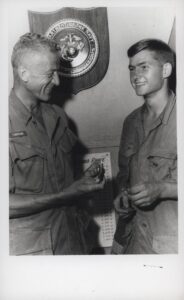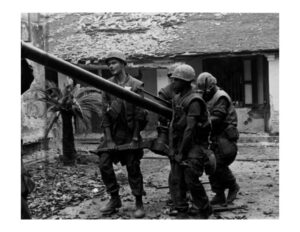Julianna Aguja ’25

A picture may tell a thousand words, but this summer I learned that they can also spark a million questions.
I spent eight weeks searching for and analyzing photographs for Professor Brigham’s forthcoming memoir about his biological father, Bruce Allen Atwell. During the Vietnam War, Atwell took some of the most seminal images of the conflict. For decades, Professor Brigham used these photographs in his courses without knowing his connection to their photographer.
My first task––identifying soldiers in a selection of Atwell’s photos––seemed insurmountable. With the help of Professor Brigham’s memoir and other texts about the war, I got a rough idea of what platoons and events Atwell photographed. I searched online for message boards, Facebook groups, and websites created by Vietnam veterans that Atwell potentially photographed. I was able to identify almost every unknown soldier in Atwell’s photos with the help of these veteran-historians and their commitment to documenting their Vietnam experiences. Knowing the names of the subjects allowed me to draft meaningful, informative captions to go along with the images for the memoir.

I spent the second half of the project searching for more of Atwell’s photographs from his time in Vietnam, as well as his time in Cuba and as a White House photographer for the Marines. From National Archives branches to small repositories at private universities, I cast a wide net when contacting archives. I was able to track down 21 photographs taken by Atwell that Professor Brigham did not have before.
The mysteries I solved and the photos I found made all the obstacles I faced during my research worth it. Professor Brigham’s story is so compelling, and working with him pushed me to consider new methods of telling history: through powerful personal narratives and photographs.
